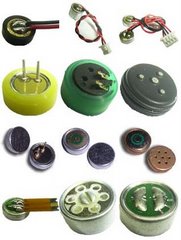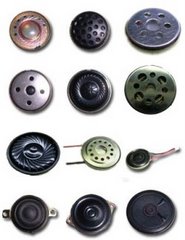Piezo Element
The good points to choose piezo element is that the cost is lower than others and you can design the sound chamber to reach a special sound. However, during assemblage, the experienced skill of soldering wires is strictly demanded, otherwise large defective products such as small sound, soundless, deviated frequency or electric leakage might happen. Defects are resulted from:
The good points to choose piezo element is that the cost is lower than others and you can design the sound chamber to reach a special sound. However, during assemblage, the experienced skill of soldering wires is strictly demanded, otherwise large defective products such as small sound, soundless, deviated frequency or electric leakage might happen. Defects are resulted from:
Piezo element and chamber both have their resonance points. How to match the two resonance points to get loud SPL and wide frequency range, the mechanical design has become a test. Material, thickness, size and depth of the sound hole and the capacity of chamber are the factors which will affect the chamber’s resonance.
The bad fix method
There are two methods for fixing the piezo elements:

Nodal mounting method
This method is to fix the nodal diameter of buzzer element to the supporting ring of the plate; better SPL can be obtained. Finding the pivot and resonance frequency of element, then the piezo element will have max vibration and SPL.
Circumference Fixing Method
This method is to fix the outside circumference of the buzzer element to the supporting right of the plate. Wide frequency range can be obtained, and easier to design. For these two methods, flexible adhesive such as silicon should be used between the buzzer element and the support ring.
Defective soldering
During the soldering, the size and position of the solder point should be the same. The temperature and pressure should be well controlled to avoid badly soldering, which will cause short circuit or insufficient isolated impedance. Besides, the iron need to be separated for the two solder points, because the ceramic wafer contain a large amount of lead, using the same iron will cause the fail of RoHS test.
有關壓電陶瓷蜂鳴片
選用壓電陶瓷蜂鳴片的好處是, 低成本,可自行設計音腔來達成特殊的聲音要求,但在組裝,焊線時的技術要求較嚴,若無相關經驗或技術,可能會有大量的不良品產生,小聲,無聲,頻率偏差,漏電都有可能會發生.這些不良大都起因於:
蜂鳴片固定方式不良
蜂鳴片常見的固定方式有二種,
節點固定(左圖):可以獲得較高的音壓,但需知道蜂鳴片的諧振頻率,找到片子振動的支點,使蜂鳴片可產生最大的振動,就可達到最大的音壓,
圓週固定(右圖):可以獲得較寬的頻寬,設計上也比較簡單,這二種方式都最好以矽膠(Silicon)等有彈性的膠來粘合機殼跟蜂嗚片,使蜂嗚片容易振動.
音腔設計不良
蜂鳴片及音腔都有各自的諧振點,如何將二個諧振點配在一起,取得最大的音壓,或是較寬的頻寬,這就考驗機構設計的能力,會影響音腔諧振的因素有: 材質, 肉厚, 音孔大小,音孔深度,音腔容積..等.
焊接不良
焊線時的焊點大小,位置都要一致,烙鐵的溫度,時間,壓力也要控制,以免把陶瓷片焊壞,造成短路或絕緣阻抗不足,另外二個焊點的烙鐵需分開使用,因為陶瓷片含大量的鉛,若再來焊銅片,會造成RoHS檢測不過的問題.
選用壓電陶瓷蜂鳴片的好處是, 低成本,可自行設計音腔來達成特殊的聲音要求,但在組裝,焊線時的技術要求較嚴,若無相關經驗或技術,可能會有大量的不良品產生,小聲,無聲,頻率偏差,漏電都有可能會發生.這些不良大都起因於:
蜂鳴片固定方式不良
蜂鳴片常見的固定方式有二種,
節點固定(左圖):可以獲得較高的音壓,但需知道蜂鳴片的諧振頻率,找到片子振動的支點,使蜂鳴片可產生最大的振動,就可達到最大的音壓,
圓週固定(右圖):可以獲得較寬的頻寬,設計上也比較簡單,這二種方式都最好以矽膠(Silicon)等有彈性的膠來粘合機殼跟蜂嗚片,使蜂嗚片容易振動.
音腔設計不良
蜂鳴片及音腔都有各自的諧振點,如何將二個諧振點配在一起,取得最大的音壓,或是較寬的頻寬,這就考驗機構設計的能力,會影響音腔諧振的因素有: 材質, 肉厚, 音孔大小,音孔深度,音腔容積..等.
焊接不良
焊線時的焊點大小,位置都要一致,烙鐵的溫度,時間,壓力也要控制,以免把陶瓷片焊壞,造成短路或絕緣阻抗不足,另外二個焊點的烙鐵需分開使用,因為陶瓷片含大量的鉛,若再來焊銅片,會造成RoHS檢測不過的問題.








